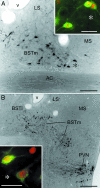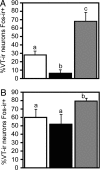Valence-sensitive neurons exhibit divergent functional profiles in gregarious and asocial species
- PMID: 17071744
- PMCID: PMC1636570
- DOI: 10.1073/pnas.0606278103
Valence-sensitive neurons exhibit divergent functional profiles in gregarious and asocial species
Abstract
The medial bed nucleus of the stria terminalis (BSTm) influences both social approach and social aversion, suggesting that this structure may play an important role in generating motivational and behavioral differences between gregarious and asocial species. However, no specific neurons have been identified within the BSTm that influence species-typical levels of sociality or that mediate approach and avoidance. Using five songbird species that differ selectively in their species-typical group sizes, we now demonstrate that vasotocin-immunoreactive (VT-ir) neurons of the BSTm exhibit very different immediate early gene responses to same-sex stimuli in gregarious and asocial species. Exposure to a same-sex conspecific increases VT-Fos colocalization in gregarious species while decreasing colocalization in relatively asocial species. We additionally demonstrate that these neurons are selectively activated by social stimuli that normally elicit affiliation (positively valenced social stimuli) but not by stimuli that elicit aversion (negatively valenced social stimuli). Constitutive Fos activity of the VT-ir neurons is also significantly greater in the gregarious species, and the two most social species express significantly more VT-ir neurons. These findings demonstrate that the properties of valence-sensitive neurons evolve in relation to sociality and indicate that gregarious species accentuate positive stimulus properties during social interactions.
Conflict of interest statement
The authors declare no conflict of interest.
Figures





Similar articles
-
Vasotocin neurons in the bed nucleus of the stria terminalis preferentially process social information and exhibit properties that dichotomize courting and non-courting phenotypes.Horm Behav. 2009 Jan;55(1):197-202. doi: 10.1016/j.yhbeh.2008.10.007. Epub 2008 Nov 1. Horm Behav. 2009. PMID: 19013174 Free PMC article.
-
Nonapeptides and the evolutionary patterning of sociality.Prog Brain Res. 2008;170:3-15. doi: 10.1016/S0079-6123(08)00401-9. Prog Brain Res. 2008. PMID: 18655867 Free PMC article. Review.
-
Cryptic regulation of vasotocin neuronal activity but not anatomy by sex steroids and social stimuli in opportunistic desert finches.Brain Behav Evol. 2010;75(1):71-84. doi: 10.1159/000297522. Epub 2010 Mar 19. Brain Behav Evol. 2010. PMID: 20332615 Free PMC article.
-
Behavioral relevance of species-specific vasotocin anatomy in gregarious finches.Front Neurosci. 2013 Dec 17;7:242. doi: 10.3389/fnins.2013.00242. eCollection 2013. Front Neurosci. 2013. PMID: 24381536 Free PMC article.
-
Steroid-induced plasticity in the sexually dimorphic vasotocinergic innervation of the avian brain: behavioral implications.Brain Res Brain Res Rev. 2001 Nov;37(1-3):178-200. doi: 10.1016/s0165-0173(01)00118-7. Brain Res Brain Res Rev. 2001. PMID: 11744086 Review.
Cited by
-
The effect of acute social isolation on neural molecular responses in components of the social decision-making network.BMC Genomics. 2024 Aug 8;25(1):771. doi: 10.1186/s12864-024-10653-z. BMC Genomics. 2024. PMID: 39118023 Free PMC article.
-
Endogenous vasotocin exerts context-dependent behavioral effects in a semi-naturalistic colony environment.Horm Behav. 2009 Jun;56(1):101-7. doi: 10.1016/j.yhbeh.2009.03.017. Epub 2009 Mar 31. Horm Behav. 2009. PMID: 19341739 Free PMC article.
-
Evolving nonapeptide mechanisms of gregariousness and social diversity in birds.Horm Behav. 2012 Mar;61(3):239-50. doi: 10.1016/j.yhbeh.2012.01.005. Epub 2012 Jan 13. Horm Behav. 2012. PMID: 22269661 Free PMC article. Review.
-
The role of vasopressin in olfactory and visual processing.Cell Tissue Res. 2019 Jan;375(1):201-215. doi: 10.1007/s00441-018-2867-1. Epub 2018 Jun 27. Cell Tissue Res. 2019. PMID: 29951699 Free PMC article. Review.
-
Recent evidence for rapid synthesis and action of oestrogens during auditory processing in a songbird.J Neuroendocrinol. 2013 Nov;25(11):1024-31. doi: 10.1111/jne.12055. J Neuroendocrinol. 2013. PMID: 23746380 Free PMC article. Review.
References
Publication types
MeSH terms
Substances
LinkOut - more resources
Full Text Sources

